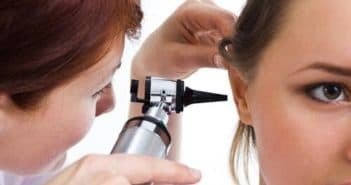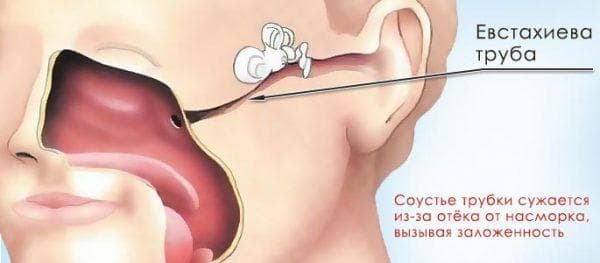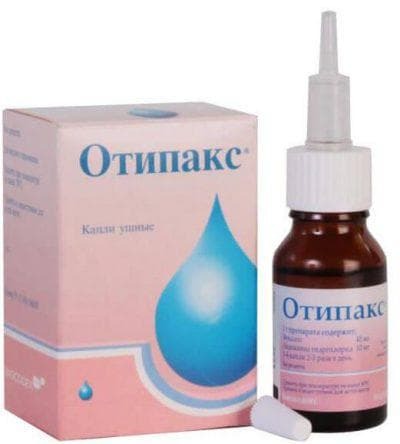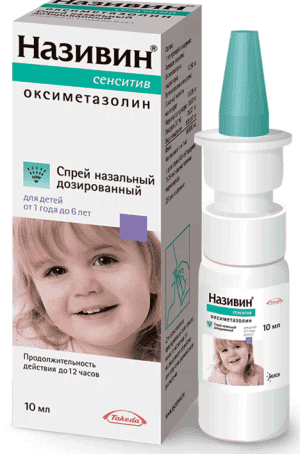
Eustachiitis is a pathological process characterized by inflammation that affects the auditory tube. Its danger is that it disrupts the ventilation of the tympanum and promotes the formation of an average otitis of the catarrhal type. Eustachiitis can be recognized by such signs as stuffiness in the ear, hearing loss, noise in the ears. Symptomatology can be one-sided and two-sided.
Content
- 1 description and code ICD 10
- 1.1 clinical picture
- 1.2 Types
- 2 treatment of acute
- 2.1 Children
- 3 chronic form of treatment
- 3.1 Home remedies for
- 4 children How long treated
- 5 Possible complications
description and code ICD 10
Eustachian tube is a connecting element between the drum cavity of the middle ear and the nasopharynx. Its task is reduced to balancing the pressure inside the drum cavity according to the external pressure of the atmosphere. And although the size of the pipe is not that big, even a slight swelling in the walls of the auditory tube due to inflammation can lead to a violation of its patency with the formation of eustachyte.
In the photo - eustachyte:

For this reason, air from the pharynx no longer penetrates into the cavity of the middle ear and there is the formation of a catarrhal pathological process. The nature of the flow distinguishes between acute and chronic eustachiitis. According to ICD 10, the disease code is H65-H75.
Clinical picture
In the case of a sharp narrowing and inflammation of the tube, conditions are created for the formation of an acute pathological process. It is characterized by the following clinical picture:
- sensation of congestion and extraneous sound in the ears;
- intense perception of your head;
- gives the impression of water pouring in the ear;
- severe pain;
- hearing loss;
- temperature rise.
On video, how to treat eustachyte:
Since the tympanic membrane is limited in mobility, it affects the hearing loss by 20-30 dB.If the pathological process is of an infectious nature, then the temperature rises and the concentration in the Eustachian tube of the inflammatory fluid is observed. The vital activity of harmful microbes contributes to suppuration, which leads to the development of severe complications in the form of otitis. If the treatment is incorrect or untimely, the process may become chronic.
 How is treated and how the adhesive otitis looks, will help to understand the information from this article.
How is treated and how the adhesive otitis looks, will help to understand the information from this article.
But what antibiotics for otitis in children should be used, this article will help to understand.
It will also be interesting to see.as it looks on the photo bullous otitis: http: //prolor.ru/u/bolezni/otit/ bulleznyj.html
But what antibiotic is better for otitis in adults, this article will help to understand.
In this case, the clinical picture is exacerbated, which leads to the following changes:
- atrophy of the tympanic membrane, as a result of which it becomes turbid, and in some areas there is perforation;
- persistent narrowing of the auditory tube;
- marked form of hearing loss.
Types of
Eustachiitis is classified according to the course of the inflammatory process to acute and chronic. Acute inflammation is not characterized by a rise in temperature. There is also no pain in the ear, but the hearing is reduced.

Eustachian tube
Hearing loss is determined by taking into account the level of fluid that is concentrated in the ear as a result of the inflammatory process.
During the head tilt, the fluid level changes, and the hearing normalizes. For a chronic pathological process, a persistent character of a decrease in the size of the auditory tube is characteristic.
Also eustachyte can be one-sided and two-sided. In this case, consideration is given to one or two sections of the auditory tube undergoing pathological changes.
Treatment of acute form
In the treatment of acute inflammation in adults, it is necessary to use drops or sprays with vasoconstrictive effect. Thanks to these drugs, it is possible to reduce swelling of the nasopharynx and restore the patency of the auditory tube. For the same purposes, antihistamines and drops are included in the therapy regimen. The OTipax remains the most effective( and how it is worth using Otypax with ear pain in the child will help understand this article)

Otypax
Given the type of pathogen that affected the development of acute eustachiitis, treatment may involve antibiotics or antiviral drugs. They can be presented in the form of tablets and injections. In addition to medicines, such methods of physiotherapy as UHF, UFO, laser therapy and pneumomassage can be used.
Children
For the treatment of inflammation of children do not need to send them to the hospital. All manipulations can be performed on an outpatient basis. To remove unpleasant symptoms of eustachyte in children, and to prevent the process from becoming chronic, the following recommendations should be adhered to:
- Taking antiallergenic or antibacterial drugs .Thanks to them, it is possible to eradicate the cause of the pathological process.
- Antihistamines and drops with vasoconstrictive effect .Thanks to them it is possible to stop puffiness and to facilitate breathing. To effective vasoconstrictive drops should be attributed Nazivin( and here's how to use Nazivin for children, to help understand this article), Glazolin, Vibrocil( and here are some reviews about drops in the nose of Vibrocil exist, described in this article).But antihistamines include Suprastin( and here's how to use Suprastin for laryngitis in children, this article helps to understand), Fenistil, Tavegil.

Nazivin
- Injection of adrenaline or hydrocortisone solution .Pour the selected drug into the eustachian tube through the catheter. There, proteolytic enzymes can also be injected. They allow you to dissolve pus, located inside the ear and reduces hearing.
- Pneumatic massage of the tympanic membrane, laser and wave treatment, as well as electrical muscle stimulation.
Treatment of the chronic form of
In the treatment of chronic inflammation, adults can use the above medications and methods of physiotherapy that are used to treat acute eustachyte. But this is already worth adding some traditional medicine. Thanks to an integrated approach, it will be possible to restore the patency of the pipe and prolong remission. Effective are the following:
- Juice of onion and aloe in the form of drops. They effectively purify the nasopharynx from mucus. A similar effect has juice onions. But how to use it and how to do it correctly aloe juice from the common cold to children, will help to understand this information.

Juice of onion and aloe
- Broth from such herbs as St. John's wort, calendula. They are used as a means to strengthen immunity.
- Steam procedures and inhalations with the use of natural oils or lotion with boric alcohol.
Home remedies for children
The chronic form of inflammation in children is treated only under the condition of an integrated approach. In addition to medicines that are similar to those used in the treatment of acute inflammation, the following folk remedies can be used:
- Juice of aloe and centennial .It is necessary to break the leaves, get juice from it and dilute it with a glass of water. Apply a solution for washing the ears and as drops for the nose.

Juice of aloe and centenarian
- Juice of onion. Take 1/4 part of a bulb, wrap it in a cloth, put it in a frying pan. When the vegetable is heated, squeeze out the juice and drip into the nose. The bulb itself should be grinded and placed in the ear.
- Boiled potatoes. This home method is considered one of the most effective. It is necessary to boil the vegetable, bend over it and cover the top with a towel. Inhale for 15 minutes.
- Garlic .This remedy is suitable for enhancing immunity. When treating inflammation of the Eustachian tube, rub garlic in a gruel, add oil and wait 14 days. Apply the product as a drop for the nose and ear.
How long is
treated For acute treatment of eustachitis treatment takes about 1-2 weeks. The determining factor is also the stage at which the pathological process is located, and also the degree of damage to the auditory tube.
Possible complications of
Pathological changes lead to edema formation and thickening of mucous surfaces, disturbs ventilation. With reduced pressure in the auditory tube, the tympanic membrane falls, drawing it into the cavity. This serves as an excuse for ear congestion and autotomy.
Gradual development of stenosis of the auditory tube and adhesion of its walls. In this case, the death of the tissues of the tympanic membrane and its cavity is observed. If adequate therapy is not available, then eustachiitis will lead to prolonged hearing loss and complete deafness. If the inflammatory process affects the brain tissue, then this is fraught with such complications as a fatal outcome.
Eustachiitis is a pathological process that is peculiar to children and adults. You can recognize it by painful sensations, ear congestion and hearing loss. Treatment is appointed taking into account what type of inflammation is acute and chronic. In case of acute inflammation, therapeutic measures should be taken as soon as possible to prevent the process from becoming chronous.
